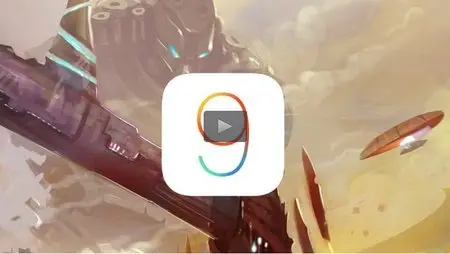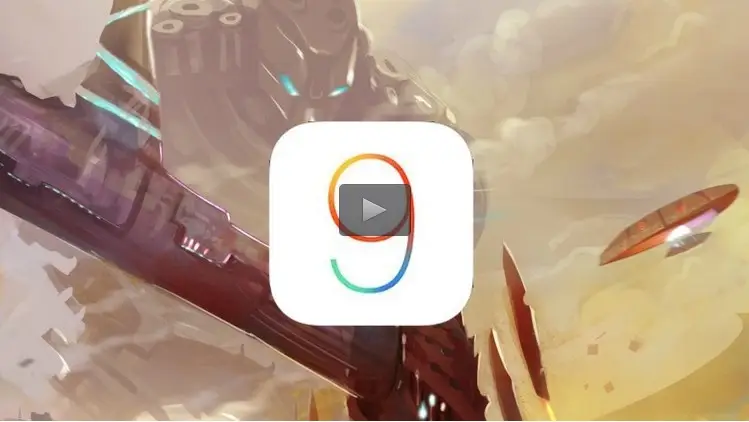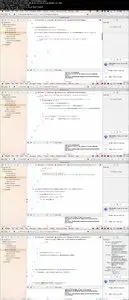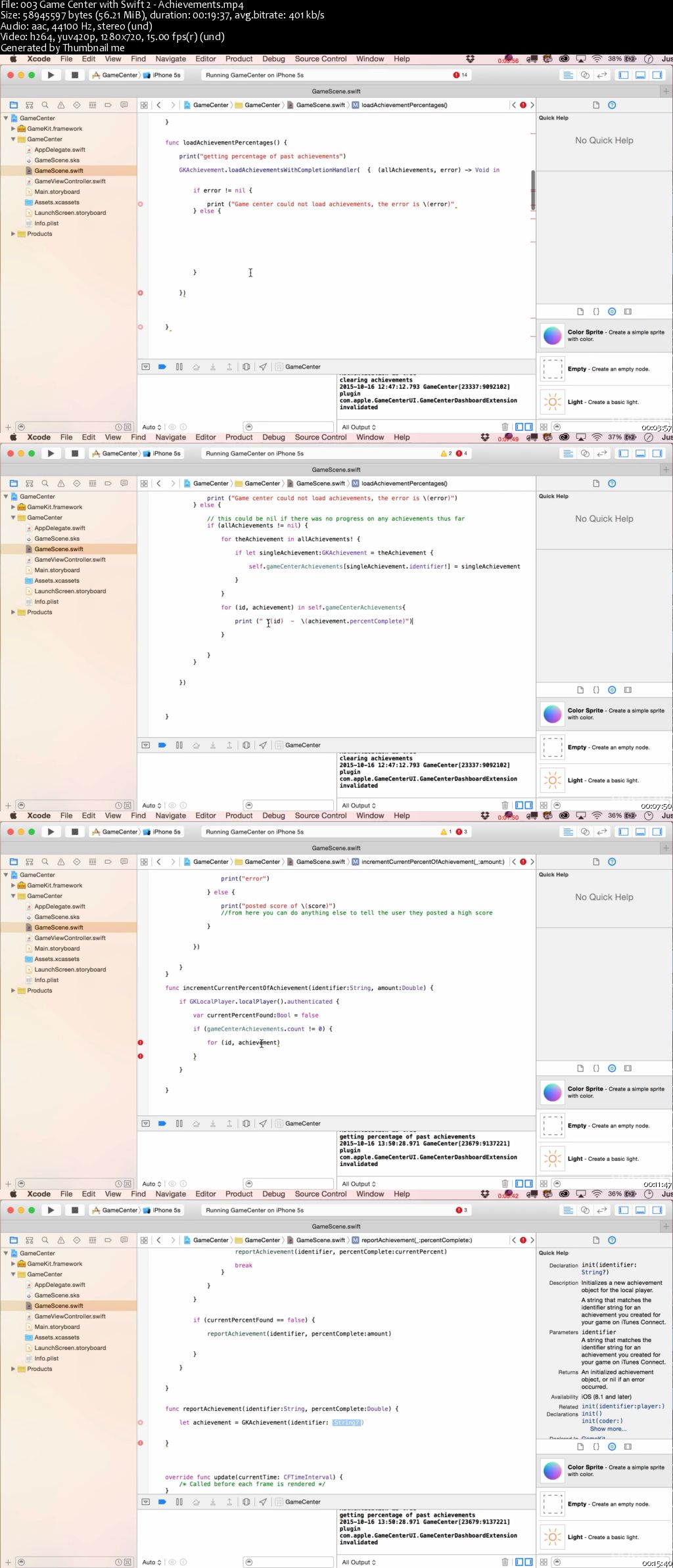Udemy – Everything iOS9
WEBRip | MP4/AVC, ~399 kb/s | 1280 x 720 | English: AAC, 60.8 kb/s (2 ch), 44.1 KHz | 1.14 GB
Genre: Development / Programming Languages | Language: English | +Project Files
WEBRip | MP4/AVC, ~399 kb/s | 1280 x 720 | English: AAC, 60.8 kb/s (2 ch), 44.1 KHz | 1.14 GB
Genre: Development / Programming Languages | Language: English | +Project Files
Learn In-App Purchasing, On-Demand Resources, Game Center and much more in this Swift 2, iOS9 and SpriteKit course.This series of videos will focus on iOS9-related topics. All of these use Swift 2, SpriteKit, Xcode 7 and apply in most cases to both iOS and tvOS. There is no recommended viewing order for these topics. Jump right into any of the topics below
On-Demand Resources in iOS9
In this video tutorial we will discuss the Swift 2 code related to loading On-Demand Resources, or simply ODR. ODR can drastically reduce the initial size of your app, and allow your users to only download what they need, when they need it. For example, you could hold off loading images / sounds for level 2 of a game if the player will still stuck on level 1.
Take Photos and Access the Camera Roll then Use them in a Sprite Kit Game!
Learn how program a SpriteKit and Swift 2 based app that allows user's the option to add pictures from their camera or camera roll into the game or scene, mask the images, then adjust the layout of the picture within the mask (zoom in / out, move it, rotate, squash and stretch it). The edited masked-image can then appear in ANY other scene throughout the lifespan of the app (it's saved as an NSUserDefault).
In-App Purchasing for iOS or tvOS Apps
Learn how to sell Consumable and Non-Consumable Products in your iOS9 or tvOS, Swift 2-based Sprite Kit App.
NSUserDefaults with Swift 2 (and how to save the location of nodes)
In this tutorial, we'll look at saving various types of data to the NSUserDefaults. The NSUserDefaults is great for information that you want to exist even if the app is closed and reopened. As long as the user does not delete the app entirely, the data is still there (the data is basically like a property list that is saved at runtime). So we'll look at saving String objects, Ints, Bools, Arrays and finally a Dictionary (where objects are moved at runtime and their location is saved for the next time the app is run).
Keyboard Input with Swift 2 for iOS and tvOS
This video tutorial will teach you how to open a view to enter keyboard input, close it and save the entered values as an NSUserDefault. Along the way you'll also see how to include placeholder text (to easily adjust the width / height, font, and font size of the input area), include custom fonts for the input text, and test the values of the input text. For example, you could include a Parental Gate in your app that prompts parents to enter a specific value, like 12 + 3, then test to see if they typed in 15. This code has been test on both iOS and tvOS devices.
Parsing a property list with Swift 2
In these videos you will learn how to parse a property list with Swift 2 and organize data (Strings, Numbers, Arrays or Dictionaries with native Swift types). Plists are useful for just about any iOS / tvOS app, but in this particular example, we will create hypothetical level data (an Array of Dictionaries), and discuss reloading the same GameScene class while "leveling up" each time.
NSNotifications with Swift 2
In this Swift 2 video tutorial, we will work with NSNotifications to call functions / send data between classes without breaking good MVC pattern (for example, having subviews send info to parent views). In our example, we'll make the GameScene post a notification to the GameViewController. We'll even pass dictionary data using the userInfo parameter.
Helper Classes with Swift 2
In this short video tutorial, we'll look at creating static variables and functions in a Helper class with Swift 2. This Helpers class will be accessible to any other class in your app, so it's great for reusable functions and saving certain variables. This is similar to working with Singleton classes, and for good measure, we'll even create a Singleton class to show you the subtle differences.
Game Center - Achievements and Leaderboards
In these Swift 2 video tutorials, we will work with Game Center to post scores to a Leaderboard and note progress toward unlocking Achievements. This of course involves setting up both a Leaderboard and Achievement in iTunes Connect, then authenticating the local player, and all the code involved with posting to Game Center. As always, you'll learn every step of the code. The finished project is SpriteKit and Swift 2 based.
What are the requirements?
- Watch our free Udemy course on Swift 2 Basics
What am I going to get from this course?
- Over 32 lectures and 7 hours of content!
- Learn hours of cutting edge Swift 2 code
- Work with On Demand Resources
- Setup Achievements and Leaderboards in your app
- Work with Property Lists
- Get Photos and Access the Camera Roll in an app
What is the target audience?
- Anyone interested in learning Swift 2
- Game Developers looking to work with iOS and tvOS
Curriculum
Section 1: Introduction
Lecture 1 Introduction Preview 02:16
Section 2: Source Files for All Tutorials
Lecture 2 Source Projects for All Tutorials Text
Section 3: On-Demand Resources in iOS9
Lecture 3 On Demand Resources in iOS9 - Part 1 15:21
Lecture 4 On Demand Resources in iOS9 - Part 2 09:34
Section 4: Take Photos and Access the Camera Roll then Use them in a Sprite Kit Game
Lecture 5 Camera Roll Sprite Kit Project - Part 1 Preview 13:34
Lecture 6 Camera Roll Sprite Kit Project - Part 2 11:35
Lecture 7 Camera Roll Sprite Kit Project - Part 3 19:49
Lecture 8 Camera Roll Sprite Kit Project - Part 4 11:46
Lecture 9 Camera Roll Sprite Kit Project - Part 5 13:25
Lecture 10 Camera Roll Sprite Kit Project - Part 6 07:59
Lecture 11 Camera Roll Sprite Kit Project - Part 7 15:14
Lecture 12 Camera Roll Sprite Kit Project - Part 8 07:50
Section 5: In-App Purchasing for iOS or tvOS Apps
Lecture 13 In-App Purchasing Tutorial - Part 1 - Initial Setup Preview 18:05
Lecture 14 In-App Purchasing Tutorial - Part 2 - Parsing Plist and Store Setup 16:09
Lecture 15 In-App Purchasing Tutorial - Part 3 - Buying a Product 15:52
Lecture 16 In-App Purchasing Tutorial - Part 4 - Delivering the Product 12:29
Lecture 17 In-App Purchasing Tutorial - Part 4 - Delivering the Product (continued) 11:41
Lecture 18 In-App Purchasing Tutorial - Part 5 - Restoring Purchases 13:59
Lecture 19 In-App Purchasing Tutorial - Part 5 - Restoring Purchases (continued) 10:36
Lecture 20 In-App Purchasing Tutorial - Part 6 - Alerts 07:16
Lecture 21 In-App Purchasing Tutorial - Part 7 - Quick Setup & Review 16:29
Section 6: NSUserDefaults with Swift 2 (and how to save the location of nodes)
Lecture 22 NSUserDefaults with Swift 2 19:44
Section 7: Keyboard Input with Swift 2 for iOS and tvOS
Lecture 23 iOS / tvOS Keyboard Input Tutorial - Part 1 17:41
Lecture 24 iOS / tvOS Keyboard Input Tutorial - Part 2 18:32
Section 8: Parsing a property list with Swift 2
Lecture 25 How to Parse a Property List - Part 1 - Strings and Arrays 09:26
Lecture 26 How to Parse a Property List - Part 2 - Arrays of Dictionaries 19:56
Section 9: NSNotifications with Swift 2
Lecture 27 Posting NSNotifications with Swift 2 06:18
Section 10: Helper Classes with Swift 2
Lecture 28 Helper Classes with Swift 2 09:53
Section 11: Game Center - Achievements and Leaderboards
Lecture 29 Game Center with Swift 2 - Initial Setup 09:12
Lecture 30 Game Center with Swift 2 - Posting High Scores 17:42
Lecture 31 Game Center with Swift 2 - Achievements 19:37
Lecture 32 Game Center with Swift 2 - Clearing Achievements and Wrap Up 06:55
LabView - Collective Books
Mega E-books Pack (2013)
Malware Centric E-book Collection
Huge Electricity, Magnetism, A..., Healing - EBooks Collection
Premium IT eBooks Collection
Huge Encyclopedias - EBooks Collection
Osprey Publishing - Military History Books Collection
Gale Encyclopedias - Full Pack
IT Books Collection (Basic - Intermediate - Advance)
Medicinal and Aromatic Plants - 50 Volume Set
Doctor Who ebooks Collection
Learning HTML Ultimate Collection
Comprehensive Robotics Books Collection
Great Royal Web Design Pack
Civil Engineering Geotechnical books
Luftwaffe Colours Collection
Many Thanks to Original uploader.
For More Rare Movies Check out my blog!
Download Links:
No Mirrors Please





